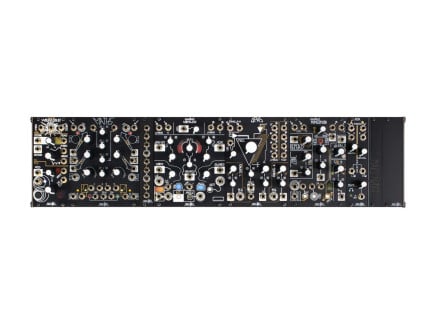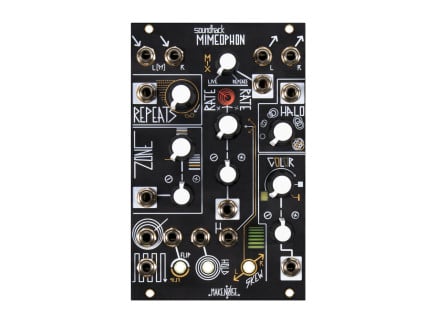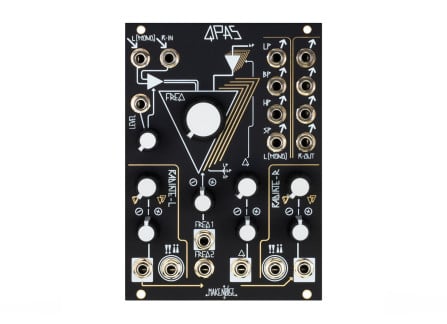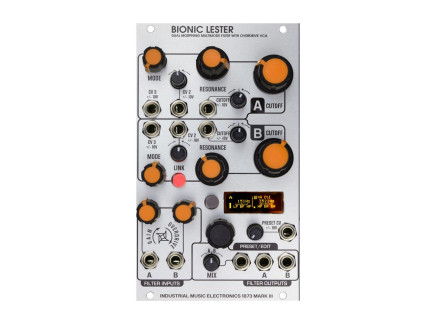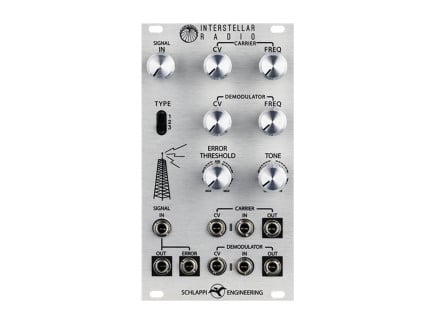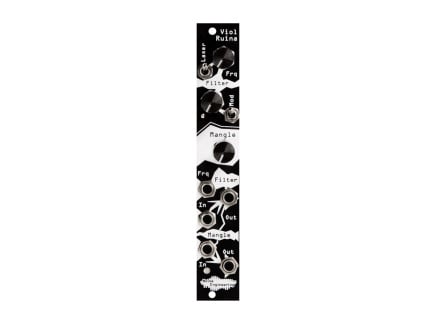2019 saw the release of some groundbreaking Eurorack filter and effect modules: thru-zero filters and audio repeaters to feedback distortion and everything in between and beyond. This is not a comprehensive list, but provides a quick overview of some of the most interesting modules that came out this year.
Make Noise QPAS and Mimeophon
This year saw the release of Make Noise's QPAS and Mimeophon. Make Noise has been working toward a comprehensive set of stereo modules for a while now, but these two modules really pushed that idea further in a refreshing direction. The Quad Peak Animation System or QPAS is an analog, quad core stereo multi-mode filter. The heart of the QPAS is four filter cores with resonant peaks. The four filter cores work together for a common goal of creating an instrument with unified controls, capable of animating the harmonics of an input signal. The frequency knob controls the center point of the cutoff and the radiate controls spread the four filter peaks from that center point. Spreading the filters from the center point adds stereo spread as the radiate controls affect the left and right outputs. There are eight outputs, organized into four stereo pairs of low pass, band pass, high pass, and Smile pass outputs. Smile pass's filter response changes based on the cutoff and radiate settings. It adds resonant peaks to the harmonic content of an input, but does little in the way of filtering and is suited for subtler, more colorful applications.
The QPAS imparts a delightful character to the input signals with everything from your standard low pass cutoff sweeps to vocal formant tones from the band pass filters and phaser-type effects from the smile pass. The resonance feeds the bandpass filter's output back into the filter and emphasizes the harmonic content at the cutoff point. The QPAS does not self-oscillate, but is great for filter pinging, creating a ringing sine wave sound with four peaks of sonic emphasis. The filter has a 2-pole 12dB/octave response but it can be changed to a steeper 4 pole, 24dB filter response by patching one of the outputs back into the input. Experimenting with different filter feedback configurations imparts different sonic character to the sound. The !!¡¡ inputs affect most elements, and each have their own character. They can be used to excite and animate complex feedback paths within the QPAS. Make Noise hasn't said what exactly these inputs do, they invite users to experiment with input signals to create different behaviors within the QPAS environment.
Make Noise/Soundhack Mimeophon is a stereo multi zone color audio repeater from Make Noise in collaboration with Tom Erbe of Soundhack. Mimeophon is from the Greek, mimeo (repeat/copy) and phon (sound). Taking inspiration from copy or Xerox art done by artists in the mid-twentieth century; the Mimeophon takes these iterative composition techniques and applies them to the realm of sound. From microsound to looper style effects, the Mimeophon colors and spatializes incoming signals. It's a delay of sorts, but is entirely modeless. The overall behaviors are created by the front panel controls alone rather than relying on preset configurations.
The Zones parameter selects one of eight color-coded zones which determines the length of the repeats, acting as a master rate control for the delay. The smallest zones are in microsound territory, great for stuttering and phasing behavior. The middle zones have the characteristics of a typical delay module, note length repeats. As you increase past these zones, the repeats move in phrase-length looper style echoes, until finally you reach 40 second long loop lengths in the final zone. There is no doppler-style pitch shift when moving from one zone to another, as the incoming sounds are written to all zones simultaneously and cascade into each other. The rate knob changes the rate of the delay within the selected zone. The skew input and button causes the delay times of the left and right outputs to move opposite one another, with one increasing in repeat time while the other decreases. This adds complex stereo imaging to the signal, particularly when combined with the Halo control. The repeats can be synced to an external clock, with divisions and multiples selected by rate and zone. The usable tempo ranges from .25Hz, one beat every four seconds, to 50Hz, or the equivalent of 3000 bpm.
Color and Halo control the timbre of the repeats. Color focuses the feedback energy and allows for the emulation of various delay types from dark oil-can echoes, BBDs, tape echoes, to bright digital delays. It gives different kinds of filtering depending on the knob setting, with multiple filters stacked together. In printing, the Halo effect refers to excess ink spreading out from the edges of printed letters and dots. In Mimeophon, Halo smears the echoes in stereo space around the edges of the repeats. When approaching the maximum settings of halo, the halos become denser and are injected into the feedback path for additional mangling. The Flip input and button reverses the audio in the buffer, while the Hold button and input freezes what's in the feedback path so nothing enters or leaves it. The microRate input is used for doppler modulation, creating chorus, vibrato, or flanger effects. In zone 0 it has an exponential or 1v/oct CV response, making the Mimeophon a great source for Karplus-strong synthesis that can be sequenced with your other oscillators. The Mimeophon does not just repeat the sounds, it adds character and life to the incoming audio signals.
IME Bionic Lester MkIII
Bionic Lester Mk3 is Industrial Music Electronics' newest filter—and it lives up to their legacy of unabashedly digital modules. It is no doubt one of the most interesting modules released this year...to read more about its design process, check out our interview with IME's Scott Jaeger.
Inspired by the design of virtual analog filters from the late-90's, this filter is capable of an incredibly versatile range of tones. It is a dual digital filter with morphable filter types, providing cutoff, resonance, and drive control as well as three CV inputs. One CV input is fixed to modulate the cutoff frequency and the other two can be freely assigned to any parameter you want. It has a pair of inputs that are normalled together for parallel routing and feature dedicated gain controls. The gain/drive goes from zero to unity gain in the center position, then soft clipping, and as you reach the most extreme settings, hard clipping. The gain control is pre-filter and can add additional harmonics to signals that are otherwise lacking.
The filter modes include your standard lowpass, bandpass, and highpass filter modes, but the Bionic Lester Mk3 has some additional filtering type. The notch filter allows for phasing style effects and the all pass/comb filter acts like a super-fast delay line whose width is changed by the frequency and feedback is controlled by the resonance. At 50% and over the filter becomes a negative feedback comb. Using CV over gain to produce a VCA in conjunction with the comb filter can result in resonator-style effects.
The filters can be routed in different modes. In Series mode, filter A is internally routed to filter B. In A CTL/Dual Peak mode, filter A's cutoff is copied to filter B, with filter B's cutoff settings added. In Stereo mode, BL MkIII has independent inputs and outputs, but filter A's controls are applied to filter B. And finally, Four-pole mode is identical to Series, but all the control settings from filter A are copied to filter B. The resonance, slope, and distortion are more intense in this mode. A two-pole output will be present at the A output, a four-pole output at the B output, and a three-pole filter at the mix output with the knob at the center position.
Like the other MkIII modules, the Bionic Lester MkIII features the preset management system which allows for saving, recalling, and morphing between presets. It stores eight complete states, including knob position, link mode, and CV assignments. The presets can be smoothly morphed through, with the controls and functions slowly melding into each other. A single channel of the Bionic Lester could make a great module, but with the two filters with linking modes and preset management system, this module goes above and beyond.
Rossum Panharmonium and Linnaeus
The Panharmonium from Rossum Electro-Music is a powerful and unique processing module that analyzes the spectral content of an incoming signal and resynthesizes it using a bank of up to 33 oscillators. The signal first passes into an analyzer, which analyzes the frequency content and breaks it down to the 33 most dominant bands, at a rate set by the slice control. This rate goes from 17ms to 200ms with a multiplier function to further slow the analyzer clock down to over six seconds between analyses. The slices can also be synced via tap tempo or with the tap/sync input. The multiplier control acts as a divider/multiplier for the synced tempo. The center freq and bandwidth controls affect the range of frequencies to be analyzed. Bandwidth allows for either pass band or notch filtering while center freq sets the center frequency of the filtering. The freeze buttons halts the spectral integrator in its tracks, holding and sustaining the spectrum currently held in the buffer. This can be used to grab bits of the audio and loop them. These frozen audio chunks can be added to preset looping sounds and can be used like oscillators. Freeze tap mode allows for a new sound to be output every time the module receives a trigger at the tap/sync input.
After being analyzed, the incoming audio passes the spectral modifiers. Voices selects how many oscillators are used to resynthesize the spectrum. This ranges from one up to 33 oscillators. The number of oscillators determines the resolution and how many partials or harmonics are resynthesized. The oscillators have controls for waveforms, which includes your standard sine, triangle, saw, pulse waveforms, but also includes crossfading sines and sawtooth waveforms.When using the crossfading waves, the Panharmonium crossfades between the pitch of the previous slice and the new slice's pitch. The different waveforms of the resampling section add different harmonic content. The pitch of the incoming audio can be adjusted by octaves or over a +/-7 semitone range.The frequency of the Panharmonium can be sequenced and tracks 1v/oct. Glide allows you to hear the reassignment of the oscillators as the frequency slides between spectral slices. It is a polyphony glide function, with each oscillator having its own glide circuit.
Blur controls the spectral lag processor, which determines how quickly the spectrum can change and imparts an effect similar to reverb to the sound. At its maximum settings, the blur will freeze the spectrum, mimicking the freeze button. Feedback takes some of the resynthesized outputs and routes it back into the analysis. If used in conjunction with the pitch shift function, it creates a barber-pole style continuous pitch shifting effect. The Panharmonium also allows you to save and recall up to 12 spectra and 12 presets. A preset stores the state of all the module settings and any incoming CV levels present when the preset is saved. A spectrum is comprised of the harmonic content of the audio currently in the buffer, as well as the center frequency and bandwidth controls, present at the time the spectrum is saved. The Panharmonium is capable of incredible sound processing, smearing, chopping, and reinventing incoming audio into its own unique yet distinctive sound.
Linnaeus, also from Rossum Electro-Music, is a stereo thru-zero state-variable filter. It features a thru-zero linear input on the filter that produces FM type tones that are rich in timbre, with modulation from external sources or its own internal modulation oscillator. The modulation oscillator has a wide frequency range, from 20Hz to 20kHz. Both the frequency and modulation index of the modulation oscillator can be modulated externally. In addition to thru-zero modulation, Linaeus precisely tracks 1V/Oct over its range. The two filters can be modulated in tandem, or the modulation can be flipped to allow for stereo complementary modulation, with one filter opening while the other closes and vice versa.
The frequency response control and CV input have buttons that enable or disable changes to the filter type for either or both filters. The resonance ranges from 0dB to 60dB, but does not self-oscillate. The resonance features both exponential input with attenuverter and 6dB/V input which is summed with the control and CV. A change of one volt at the 6dB input causes the filter to half or double its resonance. The filter is great for pinging, and even features a dedicated ping mode that allows it to become a voice in its own right. This filter excels at everything from bell tones to thick, shifting stereo imaging with a host of features and modulation possibilities.
Schlappi 100 Grit
The 100 Grit, like many Schlappi Engineering products, is at its heart a noise machine. Don't overlook it though, it is capable of so much more than just noise and death. There are three main sections, a transistor ladder lowpass VCF, OTA VCA, and a distortion with eight touch points. The lowpass filter is capable of everything from subtle tone shifts to screaming self-oscillating mayhem. The gain control adjusts the gain of the VCA and the intensity of the distortion. It features a combination latching and momentary switch that turns the gain up to 100x gain. Engage this control for otherworldly distortion.
The thing that makes the 100 Grit really shine is the interface. The touch points and multi-function controls make it a very playable instrument of sonic destruction. The eight touch points correspond to points in the signal path of the 100 Grit. They can be connected together using your fingers, alligator clips, patch cables, or anything else conductive. The touch-point interface is directly inspired by circuit bending. The touch points include distortion one and two outputs, several CV inputs, and distortion amp pins, which acts as both an input and an output. Distortion two is a secondary internal distortion that is not normally heard.
Most of the controls have a secondary function, labeled on the panel. If no patch cable is inserted, then the knob becomes a control for that secondary parameter. So for example, with nothing plugged into input two, the In 2 knob acts as a distorted resonance path in opposition to the one presented by the resonance control. With nothing plugged in to input one, it becomes a comparator of distortion one and the main output and creates square wave mayhem. With nothing plugged into FM 1, the module sends pole 2 (12dB) in to modulate the VCA which shifts the harmonic content of the signal and provides a relatively subtle distortion. The 100 Grit is all about feedback with both internal and external routing of feedback paths. This makes it one of the most unique and exciting of the items on this list.
SSF Stereo Dipole
The Stereo Dipole from SSF offers a wide range of filtering types from smooth to characterful and gritty with everything in between. The architecture of the Dipole is comprised of two dual peak multi-mode VCFs with controls for pre-filter drive, cutoff, resonance, and spread, which sets the frequency offset of the secondary peak. There are outputs per channel for a single multi-mode 12dB/oct filter, called pole, and dipole, a dual peak multi-mode filter.
The harmonic characteristics of the filter output are the result of the combination of filter topologies. The mode can be changed from high pass, band pass, and low pass. The two channels can be used together or separately, with input A normalized into input B. The dipole AB output in the center combines all four filters, whose routing can be selected by switch and sums them into a single output. The dipole section has stereo frequency and resonance controls for designing a stereo filtering image. It controls all the filters simultaneously and has double the range of the individual channel controls. This allows for maximum coverage of the entire audio spectrum. It has a range of about 0.3Hz to 50kHz and can be used to filter sub audio signals.
The resonance goes into self oscillation and can be used as a single, dual, or quad VCO or LFO that tracks 1V/Oct. The Dipole excels at making plucky pinging noises by sending triggers into the A or B inputs. The intervals of the four filters can be set by the cutoff and spread controls. Fine tuning of the spread can be used to make a four-note chord with the ability to sequence it via the 1v/oct inputs. Pinging the filter while at sub-audio rates makes an triggered/pinged/enveloped LFO with both a high point and oscillations within the resulting waveforms. In addition to self-oscillating LFOs, the Stereo Dipole can be used as a slew or lag processor to round off or add portamento to incoming sequences and sub-audio signals. The Stereo Dipole is versatile and very playable, allowing for an expressive range of sounds and sometimes unexpected results.
Mystic Circuits Portal
Portal is a source of wave wrapping harmonic destruction from Mystic Circuits. When an input signal crosses a threshold, it immediately jumps back to zero, as if it traveled through a portal. When used with triangle or sawtooth waves it creates an effect similar to oscillator hard sync but without the need for a second oscillator.
There are two modes selected by a switch. In low mode a 10Vpp signal (+/-5V) will be wrapped about five times, in the high position, the signal will be wrapped approximately 50 times. With the wrap knob all the way down and a positive control voltage input, Portal can also act as dirty VCA. The Track control determines how well the wrap tracks the input signal. When at its lowest settings, it will shut the effect off completely. Sending gates into track can create glitchy industrial tremolo effects. Bias will add a DC offset which can be used to clip the input signal into the power rails. Feedback feeds the output back into the input. At the highest feedback settings, the wrap will become much quieter because it is wrapping past the range of audible sounds.
Portal has three outputs which have their own unique flavor. Wrap is an analog approximation of a modulo function and the most intense and in-your-face output. It flattens the dynamics of a signal going through it, meaning all sounds will be adjusted to the same level, but louder sounds will have more harmonics. A louder signal has higher slope levels and therefore more wraps and more harmonics. It can be used to turn a sub-audio signal into an audio rate signal. Round will create a staircase approximation of the input signal and acts almost as an analog bitcrusher. Out of the three outputs it retains the most bass frequencies. The step size is set by the wrap control. The Spike output is a crispy and crackly approximation of the input signal. It is also the quietest output. It outputs a short trigger pulse whenever a new harmonic is generated at the wrap output. It can be used to ping envelopes or drum modules or adding a layer of high frequency content on top of the other outputs. Take a peek inside the Portal, there's madness contained inside.
Qu-Bit Prism
Prism from Qu-Bit Electronix is a filter, delay, and a decimator that morphs and mutates incoming stereo audio. The audio buffer has three axes that it can navigate through, shown by the LEDs in the center of the module.
The X and Z planes are comprised of a delay line, which can be used for comb filtering, slap back delay, or clocked delay lines. The Y axis is a decimate control, which sets the sample rate and bit depth of the output. The filter is a multi-mode filter with lowpass, bandpass, and highpass modes. The decimate can come before or after the filter. Placing the decimator before the filter allows the harsher tones intrinsic to bit reduction to be tamed. Placing the decimator last in the line allows for crunchy digital destruction. The delay buffer features a freeze input which holds whatever audio is present and loops it. This is great for glitchy stuttering and beat repeat effects.
In the clocked delay mode the time control becomes a multiplier and divider. The clocked delay really shines when used in conjunction with the freeze function as it lets you have frozen buffers that are in time with the delay clock. The comb control sets both the feedback amount at longer delay times and the comb filtering at faster delay times. It can be excited and used in a Karplus-strong manner, making the Prism its own glitchy synthesizer voice. Every control has a corresponding CV input, including filter type. Smearing, destroying, and recreating sounds is what Prism does best.
Erica / Gamechanger Plasma Drive
The Plasma Drive from Erica Synths and Gamechanger Audio is a high voltage distortion unit that uses a xenon filled tube and boosts your audio up to 3000v and transforms it into a series of high-voltage discharges, creating a grinding, edgy distortion unlike anything you've ever heard.
This modular adaptation includes an octave up and one or two octaves down that add additional harmonics to your sound. These can be turned on and off manually with the buttons or engaged with the trigger inputs. The trigger inputs are latching, so one trigger input will turn the effect on and another will turn it off. Additionally, there is CV over dry/wet and the voltage level (control the voltage with voltage). The Plasma Drive is like no other effect out there, bringing distortion into previously uncharted territory.
Noise Engineering's Endless Distortion
Noise Engineering, as always, was prolific with their modules released in 2019. This year saw the introduction of the Ruina family of modules. They were released as part of Noise Engineering "Distortion of the Month" series.
Terci Ruina features three classic analog distortion, transistor feedback, transistor fuzz, and feed-forward diode clipper. Kith Ruina is inspired by classic guitar amps. It includes a two-band EQ and drive control, implemented in a way reminiscent of overdriven amps.
The Viol Ruina is a combination analog lowpass filter and distortion. It also includes an envelope follower and self-modulating cutoff. The Pura Ruina is a three-stage CV controlled full-wave rectifier. It imparts a different flavor of distortion than your standard distortion module. Full-wave rectification takes the negative-going portion of a waveform and folds it over so it is positive-going only, effectively doubling the frequency. Seca Ruina is a multi-band distortion which divides incoming audio into three-frequency bands, each with their own drive control.
While Noise Engineering is known for their digital modules, this line of modules was all analog. They each have their own unique takes on distortion and waveshaping, providing a vast array of sounds.
New Modules from Endorphin.es
Squawk Dirty to Me is a stereo multi-mode filter with eight filter modes. These range from Moog-style 24dB/Oct transistor ladders to DJ-style isolator with much in between. Before the audio reaches the main filters, it is ran through a high pass filter, which cuts some of the low end from signals. In addition to the filters there is also a final output VCA. Squawk Dirty also features the ability to scan through the different filter types in the meta mode. This can allow for sequenced filtering, making a new filter type on every step of a sequence, or randomly scanning through the filter types for generative filtering.
The Milky Way is a stereo multi-effects module. It features two banks of eight effects, the Airways bank and the Darkwaves bank. It provides a wide range of effects from reverbs to delays and even a compressor. Each effect algorithm has two controls each with a CV input which change based on what effect is selected. Like Squawk Dirty to Me, the meta mode allows for the effect algorithm to be scanned through via CV, creating complex evolving and morphing effects.
This year saw an incredible diversity of modules come out—a little bit of something for everyone. Whether you want brutal distortion or beautiful filter sweeps, 2019 delivered. This is just a taste of what was released this year, there was an incredible amount of diversity and exciting offerings in the Eurorack marketplace. I have a feeling that 2020 is going to be an exciting year, building on the concepts that were laid out over the course of the last year. With NAMM just around the corner we won't have to wait long to find out what kind of offerings are in store for next year.


